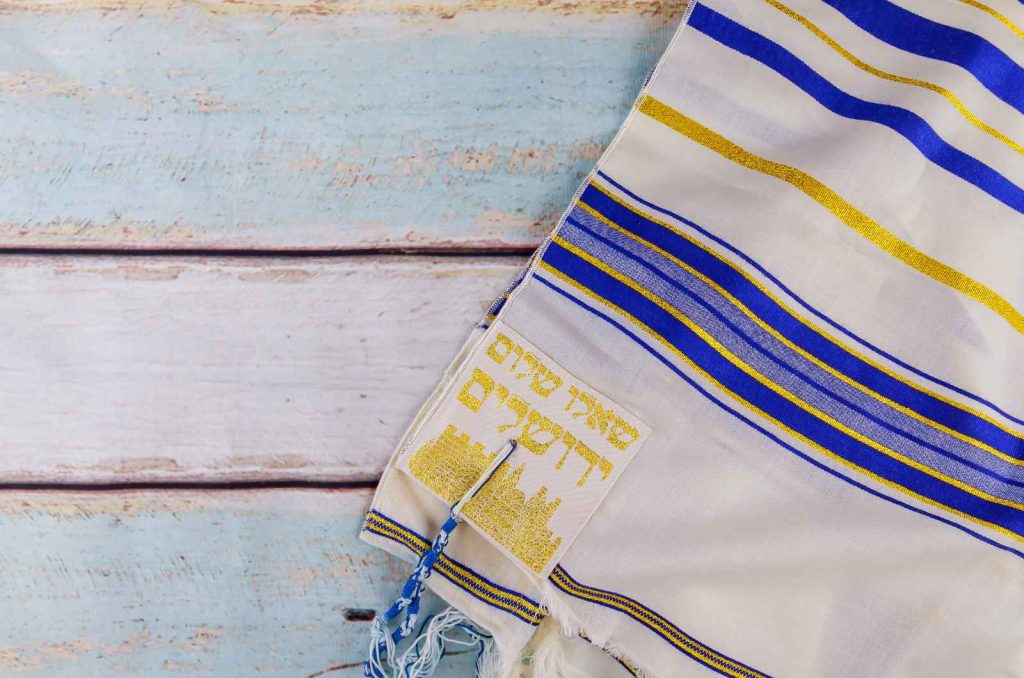
A Tallit is a special garment worn by Jewish men during morning prayers. It is an outer garment, typically made of wool, cotton, or silk, with fringes (tzitzit) attached along the four corners. The word “tallit” is derived from the Hebrew word “tallis,” meaning “cloak” or “mantle.” The tallit is one of the most important items of clothing in the Jewish faith, and is worn to remind the wearer of their obligation to follow the laws of God.
The tallit is traditionally worn during morning prayers, but can also be worn during other times throughout the day, including during holy days and festivals, as well as in the synagogue. The tallit is also sometimes called a “tallit katan,” which means “small tallit.” This is because it is typically smaller than the more traditional version and is meant to be worn under clothes.
The tallit is a symbol of God’s presence with the wearer, and is meant to remind them of the importance of following the commandments. The four corners of the tallit are decorated with tzitzit, which are strings made of wool, cotton, or silk. Each of the tzitzit are tied with a special knot, and there are usually a total of 8 tzitzit on each corner. On each corner, one of the tzitzit is longer than the other seven.
The tallit is traditionally made of white fabric, although other colors are sometimes used. The fringes of the tallit are traditionally black, although some people choose to use other colors. The traditional tallit also has a special pocket in the front, which is meant to contain the Torah scrolls.
The tallit is an important part of Jewish tradition and is often used during special occasions, such as weddings and Bar Mitzvahs. It is also a sign of respect and commitment to the Jewish faith. The tallit is often gifted to those who are celebrating a special occasion, such as a Bar Mitzvah, and can be a cherished heirloom that is passed down through the generations.
The tallit is an important part of Jewish culture and is a reminder of the importance of following the laws of God. It is a symbol of faith and commitment, and is a reminder of the connection between the wearer and God. The tallit, galileesilks for example, is a beautiful and meaningful item of clothing that is an important part of Jewish tradition.
?What is the purpose of wearing a tallit
The purpose of wearing a tallit is to serve as a reminder of the commandments of God and of the commitment to serve Him. The tallit is an outer garment, typically made of wool, cotton, or silk, with fringes (tzitzit) attached along the four corners. The tallit is traditionally worn during morning prayers, but can also be worn during other times throughout the day, including during holy days and festivals, as well as in the synagogue.
The tallit is a symbol of God’s presence with the wearer, and is meant to remind them of the importance of following the commandments. The four corners of the tallit are decorated with tzitzit, which are strings made of wool, cotton, or silk. Each of the tzitzit are tied with a special knot, and there are usually a total of 8 tzitzit on each corner. On each corner, one of the tzitzit is longer than the other seven.
The tzitzit serve as a reminder of the commandments of God, as they are meant to remind the wearer to keep the Mitzvot. The tallit is also a reminder of the connection between the person and God, and of the importance of following the laws of God. Additionally, the tallit serves to demonstrate the respect and commitment to the religious faith. The tallit is a beautiful and meaningful item of clothing that is an important part of Jewish tradition.
?Why is a tallit blue and white
The traditional tallit is white with a blue stripe, or stripes, running along the length of the garment. The white represents purity and holiness, while the blue stripes represent the heavens and the divine. The blue stripes are also meant to represent the four corners of the tallit, which are decorated with tzitzit, or fringes.
The blue stripes are also a reminder of the commandments of God, as represented by the tzitzit, which are strings made of wool, cotton, or silk. Each of the tzitzit are tied with a special knot, and there are usually a total of 8 tzitzit on each corner. On each corner, one of the tzitzit is longer than the other seven. The blue stripes are also a reminder of the connection between the person and God, and of the importance of following the laws of God.
The tallit is traditionally made of white fabric, although other colors are sometimes used. The fringes of the tallit are traditionally black, although some people choose to use other colors. The combination of the white and blue stripes is a reminder of faith, purity, and the divine, and is a beautiful and meaningful item of clothing that is an important part of Jewish tradition.